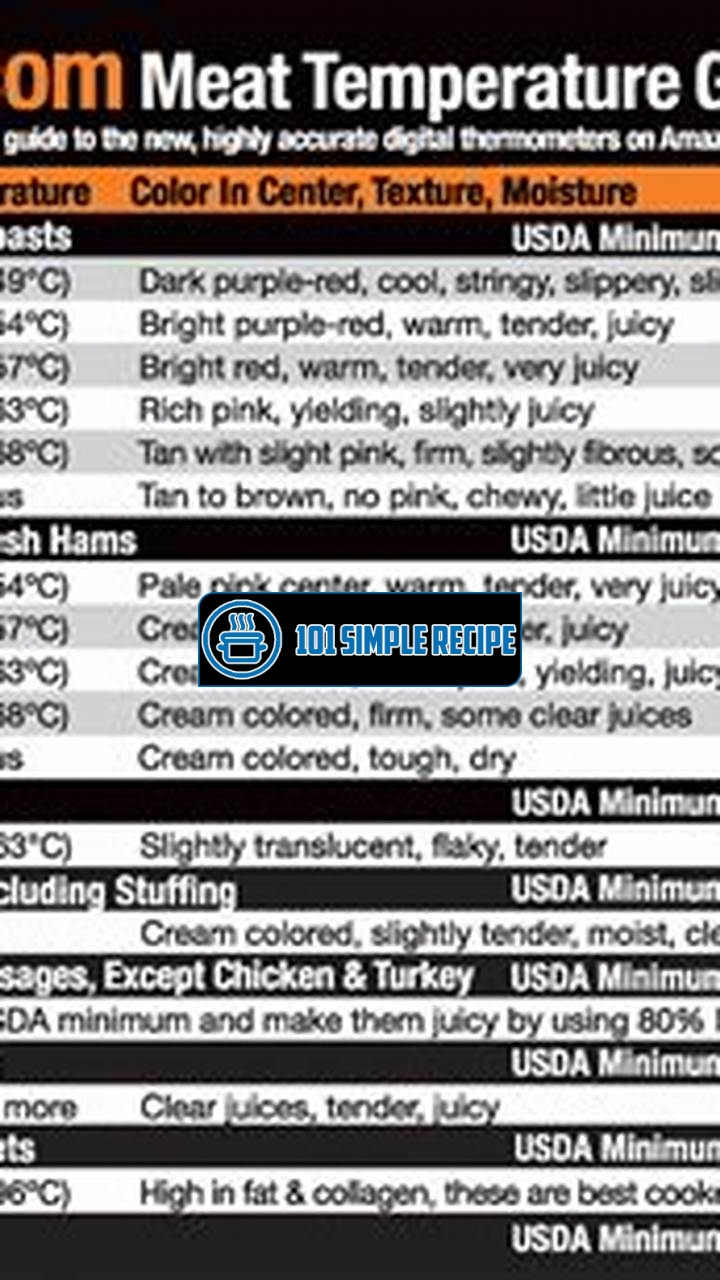If you’re a barbecue enthusiast, you know that achieving the perfect internal temperature is crucial for mouthwatering pork ribs. Cooking your ribs to the optimum temperature ensures that they are tender, moist, and packed with flavor. Finding that sweet spot can be a bit intimidating with so many conflicting opinions out there, but fear not! In this article, we will guide you through the process of cooking pork ribs to perfection by revealing the best internal temperature for outstanding results. So grab your apron and let’s get cooking!

Understanding the Internal Temperature for Pork Ribs
Discover the importance of monitoring the internal temperature of pork ribs for the perfect cooking results.
Why is Internal Temperature Important for Pork Ribs?
Explore why knowing the internal temperature of pork ribs is crucial for both safety and achieving desired doneness.
When it comes to cooking pork ribs, understanding and monitoring the internal temperature is essential. This not only ensures that the ribs are cooked to a safe and appropriate temperature, but it also helps achieve the desired level of doneness. Pork ribs that are undercooked can pose a risk of foodborne illnesses, while overcooked ribs can become dry and tough to chew.
Fun fact: Did you know that pork ribs need to reach the minimum safe internal temperature of 145°F (63°C) to eliminate harmful bacteria?
By using a meat thermometer to measure the internal temperature, you can guarantee that the ribs are cooked to perfection, with meat that is both tender and juicy. Additionally, cooking pork ribs to the proper internal temperature ensures that any connective tissues and collagen in the meat break down, resulting in tender and flavorful ribs that practically fall off the bone.
Pro tip: Keep in mind that the temperature of the meat will continue to rise slightly after you remove it from the heat source. This is known as carryover cooking, so it’s best to take the ribs off the heat just before they reach their desired internal temperature.
The Ideal Internal Temperature for Pork Ribs
Learn about the recommended internal temperature ranges for different styles of pork ribs, such as baby back ribs and spare ribs.
The ideal internal temperature for pork ribs depends on the style and cut of the ribs. For baby back ribs, the recommended internal temperature is between 180°F (82°C) and 190°F (88°C). These ribs are known for their tenderness and are often cooked until the meat easily pulls away from the bone. On the other hand, spare ribs are typically cooked to a slightly higher internal temperature of 190°F (88°C) to 200°F (93°C) to allow for the additional fat and connective tissues to render and become tender.
Ultimately, the perfect internal temperature for your pork ribs will depend on your personal preference and the specific recipe you are following. It’s a good idea to refer to a trusted recipe or cooking guide to determine the ideal internal temperature for the style of ribs you are preparing.
How to Measure the Internal Temperature of Pork Ribs
Find out the various tools and techniques for accurately measuring the internal temperature of pork ribs, including instant-read thermometers and meat probes.
Measuring the internal temperature of pork ribs is simple when you have the right tools. The most commonly used tool for measuring the internal temperature of any meat is an instant-read thermometer. This thermometer provides an accurate reading in just a few seconds when inserted into the thickest part of the rib meat.
If you prefer a tool that allows for continuous monitoring, a meat probe thermometer is a great option. This type of thermometer remains inserted in the meat throughout the cooking process and displays the temperature on a digital screen outside the oven or grill.
Quick tip: Remember to always clean and sanitize your meat thermometer before and after each use to prevent cross-contamination.
When measuring the internal temperature of pork ribs, it’s important to avoid touching the bone, as this can affect the accuracy of the reading. Instead, aim to insert the thermometer into the thickest part of the meat without hitting any bones.
By using an accurate temperature reading to guide your cooking process, you can ensure that your pork ribs are cooked to perfection every time. Remember to follow recommended temperature ranges for different styles of ribs and adjust cooking time accordingly. So grab your thermometer, get cooking, and enjoy delicious and succulent pork ribs!
The Impact of Internal Temperature on Pork Rib Texture
Understanding the impact of internal temperature on the tenderness and texture of pork ribs is essential for achieving the perfect cooking result. When cooking pork ribs, it’s crucial to cook them to the correct internal temperature to ensure a juicy and flavorful outcome. Let’s delve into the science behind the relationship between internal temperature and pork rib texture.
Breaking Down the Collagen
One of the key factors affected by internal temperature is the breakdown of collagen in pork ribs. Collagen is a protein found in connective tissue, and it plays a crucial role in the tenderness of meat. As pork ribs cook, the collagen starts to break down at specific internal temperatures.
At around 160°F (71°C), the collagen in the ribs begins to convert into gelatin. This transformation is what contributes to the tender and juicy texture of well-cooked pork ribs. The gelatin adds moisture and richness to the meat, making it incredibly flavorful.
However, if the internal temperature is too low or the ribs are not cooked for a sufficient amount of time, the collagen will not break down completely. This can result in tough and chewy ribs that are far from enjoyable to eat. It’s crucial to ensure that the internal temperature reaches the desired level to achieve the perfect texture.
Moisture Retention with the Right Temperature
In addition to the breakdown of collagen, cooking pork ribs to the correct internal temperature plays a vital role in moisture retention. No one wants dry and flavorless ribs, and achieving the right internal temperature is the key to preventing this unfortunate outcome.
When the pork ribs reach the ideal internal temperature, the moisture within the meat is better retained. This helps to create succulent and juicy ribs that will have your taste buds dancing with delight. Cooking the ribs to the correct temperature allows the protein fibers to hold onto more moisture, resulting in a mouthwatering eating experience.
On the other hand, if the internal temperature is too high, the moisture within the ribs can evaporate, leaving them dry and lacking in flavor. It’s crucial to strike the perfect balance and ensure proper moisture retention by cooking the ribs to the correct internal temperature.
The Role of Connective Tissue
Connective tissue plays a significant role in the texture of pork ribs and undergoes a transformation when cooked to the ideal internal temperature.
As pork ribs are cooked to the correct internal temperature, the connective tissue breaks down and becomes tender. This breakdown results in more effortless chewing and a melt-in-your-mouth experience.
However, if the internal temperature is not reached or the ribs are undercooked, the connective tissue will remain tough and chewy, detracting from the overall enjoyment of the dish. It’s essential to cook the ribs to the ideal internal temperature to ensure that the connective tissue transforms into a more pleasant texture.
Overall, understanding the impact of internal temperature on the tenderness and texture of pork ribs is crucial for achieving a mouthwatering result. By breaking down collagen, retaining moisture, and transforming connective tissue, cooking the ribs to the correct internal temperature ensures a truly enjoyable dining experience. So, next time you cook pork ribs, remember to pay close attention to that internal temperature!
Factors Affecting the Internal Temperature of Pork Ribs
When it comes to cooking the perfect pork ribs, achieving the right internal temperature is crucial. The internal temperature determines the doneness and tenderness of the meat. There are several factors that can influence the internal temperature of pork ribs during the cooking process. Understanding these factors will help you achieve excellent results every time.
Thickness of the Ribs
The thickness of the ribs plays a significant role in determining the cooking time and internal temperature required for optimal results. Thicker ribs will take longer to cook compared to thinner ones. This is because the heat needs more time to penetrate through the meat and reach the desired internal temperature.
Keep in mind that thicker ribs may require lower cooking temperatures to ensure that the meat is cooked evenly without burning the surface.
Basting and Cooking Methods
The basting and cooking methods you choose can also affect the internal temperature of pork ribs.
Grilling, smoking, and oven roasting are some of the popular methods used to cook pork ribs. Each method has its unique characteristics and impacts how the heat is distributed, which ultimately affects the internal temperature.
Grilling pork ribs over direct heat can result in faster cooking, but it may require more frequent basting to prevent drying out. Smoking ribs using indirect heat and a low temperature allows for a slower cooking process, resulting in tender and flavorful meat. Oven roasting provides a controlled environment, allowing even heat distribution for consistent cooking throughout the ribs.
Resting Time and Carryover Cooking
Resting time and carryover cooking are often overlooked but are essential steps in achieving the perfect internal temperature for pork ribs.
After removing the pork ribs from the heat source, it is crucial to let them rest before cutting into them. Resting allows the juices to redistribute, resulting in tender and juicy meat. It is recommended to let the ribs rest for at least 10 to 15 minutes before serving.
During resting, carryover cooking takes place. Carryover cooking refers to the residual heat that continues to cook the meat even after it has been removed from the heat source. This means that the internal temperature of the ribs will continue to rise slightly during resting. Therefore, it is important to consider carryover cooking when determining the desired internal temperature of the ribs.
Note: To achieve the perfect internal temperature for pork ribs, it is recommended to use a meat thermometer to ensure accuracy. The USDA recommends a minimum internal temperature of 145°F (63°C) for pork ribs, but many prefer a slightly higher temperature for more tender and fall-off-the-bone meat.
In conclusion, several factors can influence the internal temperature of pork ribs during the cooking process. The thickness of the ribs, basting and cooking methods, and resting time with carryover cooking all play a crucial role. By understanding and taking these factors into consideration, you can achieve the perfect internal temperature for your pork ribs, resulting in delicious and mouthwatering meat every time.
Food Safety Considerations for Pork Ribs
When it comes to cooking pork ribs, ensuring food safety is of utmost importance. Handling raw meat requires extra care and attention to prevent the risk of foodborne illnesses. By following proper food safety precautions, you can enjoy delicious pork ribs without any health concerns. Here are some important considerations to keep in mind:
Safe Minimum Internal Temperature
To prevent the growth of harmful bacteria, it is crucial to cook pork ribs to the recommended safe minimum internal temperature. The internal temperature of the ribs should reach at least 145°F (63°C) for safe consumption. This temperature ensures that any potential bacteria in the meat are destroyed, minimizing the risk of foodborne illnesses.
️ Keep in mind that using a meat thermometer is the most accurate way to determine the internal temperature of the ribs. Insert the thermometer into the thickest part of the meat, without touching the bone, to get an accurate reading.
Cross-Contamination Prevention
Cross-contamination is a significant concern when it comes to handling raw and cooked pork ribs. It is essential to prevent any contact between raw meat and cooked ribs, utensils, surfaces, or other foods to maintain food safety. Cross-contamination can lead to the transfer of harmful bacteria, increasing the risk of foodborne illnesses.
Thoroughly wash your hands, cutting boards, utensils, and surfaces with hot, soapy water after coming into contact with raw pork ribs. Using separate cutting boards and utensils for raw and cooked meats is highly recommended. This precaution reduces the chances of cross-contamination and ensures the safety of your meal.
Storing and Reheating Leftover Ribs
Properly storing and reheating leftover pork ribs is essential to maintain their safety and quality. Follow these procedures to ensure that your leftovers are safe to consume:
- Refrigeration: Place the leftover pork ribs in an airtight container or wrap them tightly with foil. Store them in the refrigerator within two hours of cooking. Make sure the refrigerator temperature is set at 40°F (4°C) or below to slow down bacterial growth.
- Reheating: When reheating leftover ribs, ensure that they reach an internal temperature of at least 165°F (74°C) to kill any remaining bacteria. You can use an oven, microwave, or grill to reheat the ribs. Make sure to heat them evenly and thoroughly.
Note: It is recommended to consume leftover pork ribs within 3 to 4 days to ensure freshness and quality. If they show any signs of spoilage, such as an unusual odor or texture, it is best to discard them.
By following these food safety considerations, you can enjoy perfectly cooked pork ribs with peace of mind. Stay aware of the necessary precautions, handle raw meat with care, and ensure proper cooking temperatures to protect both yourself and your loved ones from foodborne illnesses.
Troubleshooting Guide: Overcooking and Undercooking
When it comes to cooking pork ribs, achieving the perfect internal temperature is crucial. However, even the most experienced chefs can encounter issues like overcooking or undercooking their ribs. In this troubleshooting guide, we’ll explore common problems that may arise and provide tips on how to fix them, ensuring your pork ribs turn out tender, juicy, and flavorful every time.
Overcooked Ribs
There’s nothing worse than biting into a dry, tough piece of overcooked pork rib. But fear not, because even if you’ve accidentally overcooked your ribs, there are ways to salvage them and make them enjoyable again. Here are some techniques to try:
- Moisture is key: Overcooking can cause your ribs to become dry. To bring back some moisture, try basting them with a flavorful sauce or marinating them overnight before reheating.
- Low and slow: When reheating overcooked ribs, opt for a low temperature and longer cooking time. This allows the meat to slowly reabsorb some of the lost moisture and become more tender.
- Wrap and steam: Another method to revive overcooked ribs is to wrap them tightly in foil with a bit of liquid, such as apple juice or broth, and place them in a preheated oven. The steam created inside the foil will help to rehydrate the meat.
Remember, while these techniques can improve the texture and taste of overcooked ribs, it’s important to note that they might not return to the same level of perfection as properly cooked ribs. However, they can still be delicious and enjoyable with the right fixes.
Undercooked Ribs
Undercooked pork ribs can be a disappointment, especially when you’re expecting juicy, fall-off-the-bone meat. Fortunately, there are techniques to help remediate undercooked ribs without compromising safety or taste. Consider the following methods:
- Finish on the grill: If your ribs are undercooked but not far from the desired internal temperature, you can finish them on a grill over medium heat. This will add a smoky flavor and help to cook them further without drying them out.
- Braise and broil: For thicker racks of undercooked ribs, a combination of braising and broiling can do the trick. Place the ribs in a baking dish with a flavorful liquid, cover tightly with foil, and braise them in the oven. Then, remove the foil, brush with sauce, and broil on high heat to develop a caramelized crust.
- Slice and simmer: If your undercooked ribs are still too tough, consider slicing them into smaller portions and simmering them in a savory sauce on the stovetop. This will allow the meat to cook further while becoming tender and flavorful.
Avoiding Common Cooking Mistakes
Prevention is always better than solution, especially when it comes to cooking pork ribs. By avoiding common pitfalls, you can ensure perfectly cooked ribs every time. Here are some tips to help you avoid overcooking or undercooking:
- Use a meat thermometer: Invest in a reliable meat thermometer to accurately monitor the internal temperature of your ribs. This will help you achieve the ideal doneness without guesswork.
- Preheat and maintain consistent temperature: Make sure your grill, oven, or smoker is preheated to the proper temperature before placing your ribs inside. Additionally, try to maintain a consistent temperature throughout the cooking process to avoid uneven cooking.
- Wrap in foil: Partially wrapping your ribs in foil during the cooking process can help retain moisture and prevent overcooking. This method, known as the “Texas Crutch,” can be especially useful for longer, slow-cooked ribs.
- Allow for resting time: Once your ribs reach the desired internal temperature, remove them from the heat source and let them rest for a few minutes. This allows the juices to redistribute throughout the meat, resulting in more flavorful and tender ribs.
By following these tips, you’ll be well on your way to mastering the art of cooking pork ribs to perfection. Remember, practice makes perfect, so don’t be discouraged if it takes a few tries to get it just right. Enjoy the process, experiment with flavors, and savor the delicious results!
Thank you for reading our article on the internal temperature for pork ribs. We hope you found it informative and helpful in achieving perfectly cooked ribs every time. If you have any further questions or need more guidance, don’t hesitate to visit us again later. We are here to help you become a master of ribs! Happy cooking!
Frequently Asked Questions
Here are some frequently asked questions about cooking pork ribs:
| No. | Questions | Answers |
|---|---|---|
| 1. | What is the recommended internal temperature for pork ribs? | The recommended internal temperature for pork ribs is 145°F (63°C). However, for more tender and fall-off-the-bone ribs, you can cook them to an internal temperature of 190°F (88°C). |
| 2. | How do I measure the internal temperature of pork ribs? | To measure the internal temperature of pork ribs, insert a meat thermometer into the thickest part of the meat without touching bone. Ensure that the thermometer does not touch the grill or smoker. |
| 3. | What happens if I undercook pork ribs? | Undercooked pork ribs may be tough and chewy, and they may not be safe to eat. It is important to cook pork ribs to the recommended internal temperature to ensure they are cooked thoroughly. |
| 4. | Can I cook pork ribs to a higher temperature? | Yes, cooking pork ribs to a higher internal temperature, such as 190°F (88°C), will result in more tender and fall-off-the-bone ribs. However, be cautious not to overcook them, as they may become dry. |
| 5. | How long should I let pork ribs rest after cooking? | It is recommended to let pork ribs rest for about 10-15 minutes after cooking. This allows the juices to redistribute and results in more flavorful and moist ribs. |
| 6. | What are some recommended seasoning options for pork ribs? | Some popular seasoning options for pork ribs include BBQ rubs, dry rubs with a combination of spices, or marinades with flavors like garlic, honey, or citrus. Experiment with different seasonings to find your favorite! |
Closure and Next Steps
Thank you again for taking the time to read our article on the internal temperature for pork ribs. We hope the information provided has been helpful in your journey to achieving perfectly cooked ribs. Remember to always use a meat thermometer to ensure your ribs are cooked to the desired doneness. With practice and patience, you’ll become an expert in no time. Happy grilling, and don’t forget to visit us again for more mouthwatering recipes and cooking tips!
Jump to Recipe
Internal Temp for Pork Ribs

Learn about the recommended internal temperature for cooking pork ribs and achieve perfectly cooked ribs every time.
- 2 racks of pork ribs
- BBQ rub or seasoning of your choice
- Remove the membrane from the back of the ribs by sliding a butter knife under the membrane and lifting it away. Rinse the ribs under cold water and pat them dry with paper towels. Apply the BBQ rub or seasoning generously all over the ribs, covering both sides.
- Preheat your grill or smoker to a temperature of 225°F (107°C) for indirect cooking.
- Place the seasoned ribs on the grill or smoker and close the lid. Cook for approximately 5-6 hours or until the internal temperature reaches 190°F (88°C) for fall-off-the-bone ribs. For more firm ribs, cook to an internal temperature of 145°F (63°C).
- Once cooked, remove the ribs from the grill or smoker and let them rest for 10-15 minutes. This allows the juices to redistribute. Slice the ribs between the bones and serve.
- Enjoy your perfectly cooked pork ribs with your favorite sides and sauces. Happy grilling!






